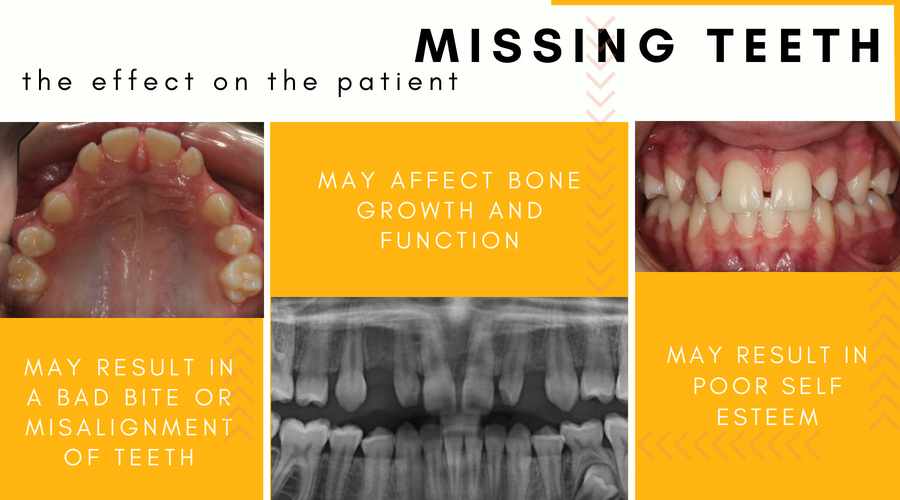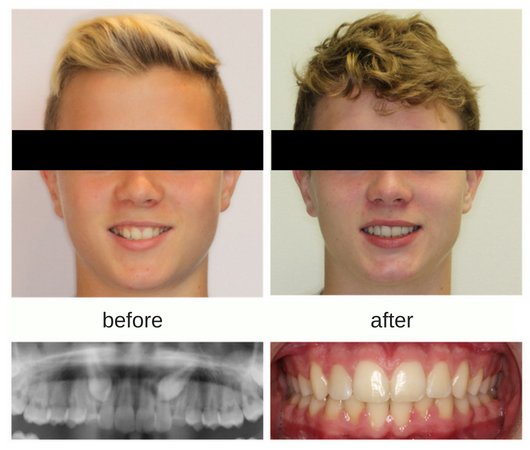Delayed eruption of adult teeth
In comparison to early tooth loss, delayed loss of baby teeth is often a reflection of poor eruption pattern of adult teeth, missing adult teeth or impacted adult teeth. Weather you are seeking an orthodontist in Mississauga or an orthodontist in Sudbury, it is prudent to see a specialist early (at least by age 7) to detect and correct these problems early so complicated treatment can be avoided later on.
Delayed eruption of first molars
The first molars that erupt at around age six are the usually the first adult teeth to erupt or grow into the mouth. These teeth do not replace any baby teeth (therefore they do not have a predecessor) and erupt just behind the first primary or baby molar. Sometimes, while these teeth are growing in, they can get stuck under the first primary molar causing a delay in eruption. In severe cases, the six year molar will cause the first primary molar to fall out prematurely and limit the space for the eruption of the adult tooth that would have replaced this tooth. In either cases, it is very important to seek the counsel of an orthodontist to allow the six year molar to erupt properly and prevent any space loss so that future adult teeth have enough space to grow in properly.

Delayed eruption due to impacted teeth
A classic example of delayed tooth eruption involved the adult canines (the sharp fangy teeth). These teeth should ideally fall out by age 11 or 12. Usually, primary teeth fall out when their adult successors resorb (chew away) their roots. This means that any delays in the eruption of the adult canines may be due to insufficient space for these to erupt or an inadequate path of eruption of these teeth. As a result, the canine teeth get impacted or stuck in the upper jaw and surgery is sometimes the only way to bring them into the mouth. When taken early enough, studies have shown that an x-ray can help diagnose which teeth are likely to get impacted. We can sometimes prevent the impaction of adult canines or other teeth by taking preventive measures and removing their primary predecesors early just by looking at an x-ray. This means that there is smaller chance for surgical intervention or extraction.

Missing Teeth
Why do some children have missing teeth?
The occurrence of missing teeth is between 0.1-16% in the general population and has a genetic basis. The likelihood of your child missing adult teeth is higher if you are also missing them. In certain cases, if a patient is naturally missing one adult tooth, there are chances that the adult tooth on the other side of the jaw is also missing, smaller in shape, deformed or possibly delayed in erupting into the mouth.
Do we really need to treat children with missing teeth?
Many parents bring their children into our Mississauga Orthodontist or Sudbury Orthodontist offices at around age 11 or 12 and even 13, thinking that their children have all their adult teeth and should be ready to start braces. Much to their surprise, during the clinical consultation we will notice that there are still baby teeth present. At this point we usually take an x-ray to determine if the adult successors to the baby teeth are either delayed in their eruption, missing or stuck in the bone (impacted).
The teeth that are most often missing are the lower second premolars followed by the upper lateral incisors and then the upper premolars. Missing teeth not only affect the appearance of your child’s smile but can also cause malocclusion (bad bite) or misalignment of the teeth when the mouth is closed. There can also be problems with bone growth and difficulty chewing.

Why is it important to see an orthodontist if your child is missing teeth:
>
Treatment of missing teeth can involve several procedures and serious cases can require both orthodontics and oral surgery. At our Port Credit orthodontics and Sudbury Orthodontics office, when we identify a patient with missing teeth early on, we work closely with your dentist and an oral surgeon to figure out long-term treatment options that are best for your child.
Treatment options for missing teeth may involve dental implants once the jaws have finished growing, a fixed bridge or a removable retainer. The other option is to move the teeth around and close the space of the missing teeth with braces and TADs so that you avoid future dental procedures like dental implants and fixed bridges These options would be discussed with you earlier when your child is young so that you can explore all your options and talk to your dentist and oral surgeon.

Smile Gallery
-

Melissa
-

Oliver
-

Melissa
-

Oliver
-

Melissa
Get a Free Consultation
Make an appointment today and start your child’s journey to a healthy and beautiful smile with Hometown Orthodontics.





